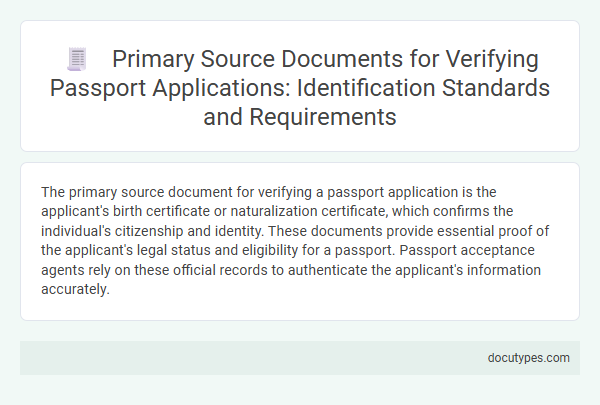The primary source document for verifying a passport application is the applicant's birth certificate or naturalization certificate, which confirms the individual's citizenship and identity. These documents provide essential proof of the applicant's legal status and eligibility for a passport. Passport acceptance agents rely on these official records to authenticate the applicant's information accurately.
Introduction to Primary Source Documents for Passport Verification
| Introduction to Primary Source Documents for Passport Verification | |
|---|---|
| Definition | Primary source documents are original records used to verify personal identity during the passport application process. |
| Purpose | Ensure the applicant's identity is authentic, preventing identity fraud and unauthorized passport issuance. |
| Examples of Primary Source Documents | Birth certificates, previous passports, naturalization certificates, and consular reports of birth abroad. |
| Importance in Verification | Serve as the most reliable evidence for confirming applicant information, such as name, date of birth, and citizenship status. |
| Authorized Entities | Passport agencies, government officials, and authorized agents use primary source documents to validate every passport application. |
Importance of Accurate Identification in Passport Applications
Accurate identification is crucial in passport applications to ensure the legitimacy of the applicant's identity. The primary source document serves as the foundational proof required to verify personal information and prevent identity fraud.
- Primary Source Document Identification - The primary source document for verifying a passport application is typically a government-issued birth certificate or a previous valid passport.
- Verification Importance - This document confirms the applicant's full name, date of birth, and citizenship status, ensuring the correct issuance of the passport.
- Fraud Prevention - Accurate identification through the primary source document helps prevent identity theft and unauthorized passport issuance.
Types of Primary Source Documents Accepted
The primary source document for verifying a passport application is an official government-issued identification that confirms the applicant's identity and citizenship. These documents must be original or certified copies to ensure authenticity and prevent fraud.
Accepted types of primary source documents include a U.S. birth certificate, a previous U.S. passport, and a Certificate of Naturalization. Other documents such as Consular Reports of Birth Abroad and Certificates of Citizenship are also recognized as valid proof for passport applications.
Standards for Document Authenticity and Validation
The primary source document for verifying a passport application is the applicant's government-issued birth certificate or national identification card. Standards for document authenticity and validation ensure the identification documents are genuine and comply with official guidelines.
- Official Government Issuance - Documents must be issued by a recognized government authority to be accepted for verification.
- Security Features - The document should include watermarks, holograms, or security threads to prevent counterfeiting.
- Data Consistency - Information on the document must match the applicant's details provided in the passport application.
These standards safeguard against identity fraud by validating document authenticity during the passport application process.
Government-Issued Identification: Passports, National IDs, and Driver’s Licenses
The primary source document for verifying a passport application is government-issued identification. This includes passports, national IDs, and driver's licenses, which serve as official proofs of identity and citizenship. These documents are essential for confirming personal details and eligibility during the passport application process.
Birth and Citizenship Certificates as Verification Evidence
The primary source document for verifying a passport application is typically your birth certificate or citizenship certificate. These documents serve as official proof of your identity and citizenship status.
A certified birth certificate establishes your place and date of birth, critical details for passport validation. Citizenship certificates confirm your legal status if you were born outside the country or have obtained citizenship through naturalization.
Handling Foreign Documents in Passport Applications
The primary source document for verifying a passport application is the applicant's birth certificate or naturalization certificate. These documents provide essential proof of identity and citizenship required by passport authorities.
Handling foreign documents in passport applications requires careful evaluation to ensure authenticity and compliance with regulations. Foreign birth certificates or naturalization papers must be translated if not in English and certified by appropriate authorities. You should submit original documents or certified copies to avoid delays in processing your application.
Document Translation and Notarization Requirements
The primary source document for verifying a passport application is your original birth certificate or previous passport. Document translation must be certified and accompanied by a notarization to ensure authenticity and compliance with government standards. Accurate translation and proper notarization prevent delays and help verify your identity efficiently.
Common Pitfalls and Mistakes in Submitting Identification Documents
What is the primary source document for verifying a passport application? The primary source document is typically a certified birth certificate or a previously issued, undamaged U.S. passport. Common pitfalls include submitting photocopies instead of originals, expired identification, or documents with mismatched personal information.
What Is the Primary Source Document for Verifying a Passport Application? Infographic

